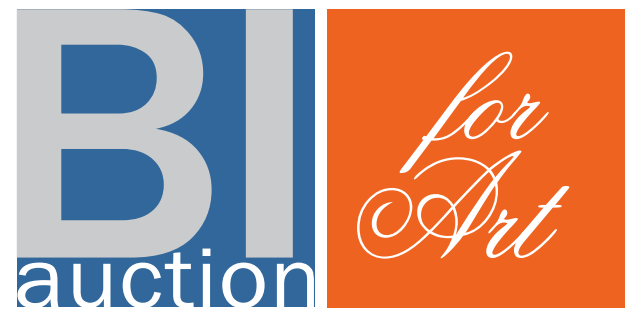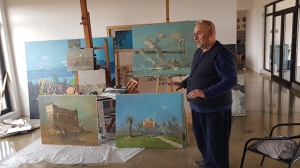Interview with an Artistic Couple, Part 1: Mamuka Tsetskhladze
INTERVIEW
The coronavirus has emptied our streets and filled our heads with anxiety and concern. Especially at times like this, we need to be reminded of the beauty that exists in our world. With that in mind, GEORGIA TODAY, at the invitation of BI Auction, sat down for an interview with a couple of artists who are very important to the Georgian contemporary art scene: Mamuka Tsetskhladze and Lia Shvelidze. The painter husband-and-wife discuss with us their growing up in the Soviet Union, their art influences, the story of how they met, and walk us through the process of the creative work.
Mamuka, who first introduced you to art? How and when did you start painting?
I started taking painting lessons at the former Pioneer Palace, now known as the Georgian National Youth Palace, when I was in the 7th – 8th grade at school. My teachers were Mikheil Tsalkalamanidze and Bondo Bakuradze. They explained and demonstrated how to paint different things. After that, I started going to the Nikoladze Art School, where I was taught by Misha Gabunia for two years. After the two years it was time to enroll in the Tbilisi State Academy of Art, so I went to Iura Mekvabishvili, who gave me private lessons. I went to the Tbilisi State Academy of Art in 1980 and studied in the studio of famous artist Korneli Sanadze for five years.
Before taking professional art classes for the first time, did you try to paint on your own?
I used to draw, like every other child. After seeing my drawings, they must have thought I was better at it than the average child my age, so they had me start taking art classes.
At the beginning of your career, what/who had the biggest influence on your art-pieces and shaped you as an artist?
Probably visiting the Hermitage, the big painters: Leonardo, Raphael, El Greco, Delacroix, the impressionists, Van Gogh, and the list goes on...
The influence of the impressionists is appreciated in your work to this day.
Every artist has been influenced by something; there is simply no other way. First, you have to learn from the existing examples and only then can you develop your own style and choose a theme. I have named a lot of artists, but I don’t have one or two favorites, I like a number of painters.
Does this mean that you can’t say exactly which artist or art movement had the biggest impact on you?
That’s right. All of it, from the ancient Egyptian Fayum portraits to Jeff Koons’ latest art work; all are important to me. I believe that in every century there were great painters who have their designated place in history.
How important is a professional education for an artist’s development?
Some technical education is necessary. If a person has a gift, 1-2 years are enough. Some immensely gifted students can learn everything in a week. You can see right at the beginning who’s missing what and how long they need to study. It’s crucial for an artist to know the technical details of painting, such as construction, palette, brushes. Painting is hard to imagine without a basic education.
How hard was it to grow as an artist during the soviet regime?
There were specific themes [we had to stick to]. You could paint the workers, or the landscapes, or still life, or choose the space theme, where abstraction was possible. I can’t say that we were under a lot of pressure and they were hanging people, because I didn’t experience it that way. When I was developing as an artist, the strictest times in the soviet regime had already passed. At the time, the Soviet Union was taking its last breaths, so to say, so the limitations didn’t affect me or my work.
How would you assess the Georgian modern art scene and, generally, our country’s place in world art?
I would say that we are trying and moving forward. As for modern art, it is a whole independent field, divided into two parts: the one before Picasso and the one after him. I believe that people nowadays have more information and means of discovering art, which is noticeable, because they don’t ask silly questions anymore.
Where do you find inspiration while painting your cityscapes?
When you are 50 years old, going on 60, and you’re still painting, inspiration doesn’t work anymore: there’s no need for it. When you’ve been painting for 40 years, this means that it is a part of you already; otherwise you would not be able to do it for so long.
What is the main mission of art? What purpose does it serve in a person and society?
A person should be able to look at something that someone else made. Maybe they’ll like it and when they go to the museum they won’t think the art piece just appeared from nowhere. In the Netherlands, they have this thing: they take a dying person, who has just hours left to live, to the museums. This person looks at Rembrandt, Leonardo, etc. to say farewell to something which is the most valuable Manmade thing in the world – art, painting.
In modern art, painting has a lesser role than art installations. That being today’s reality, what do you think is the future of painting?
These are just different directions of art: video art, object, installation, performance. They don’t interfere with anything. There will always be Picasso and Van Gogh. Today, we are at a stage of development where everything can turn into art. Everybody has the freedom to create whatever they want. I choose to look at it in a positive way.
Have you ever tried any other art direction apart from painting?
I have written a few short stories and I always thought that if not a painter, I would have become a writer. For example, I read “The Museum of Innocence” by Orhan Pamuk and it had a special impact on me - it changed me, I even experienced a cultural shock. I’m jealous of big writers’ work, you might think “hey, I could have written this myself,” but you can’t, really.
Tell us how you paint.
I don’t have a specific routine. One day I may not paint at all; I might just read a book. Another day, I may start painting and not stop for a week or 10 days. What is important is that every painting is a process and needs time. It is also necessary to take a break and look at your work from the side. There have been moments when I didn’t know when to stop and went too far. At those times it’s better to start fresh, from the beginning.

Have you ever thought about teaching others how to paint?
Lia is the one with the teaching experience, although I taught for a year at the Nikoladze Professional Art School. Lia has had a studio since 2006, where she teaches people of different ages. She doesn’t teach to prepare students for the Art Academy, but to show them what art is and how it can also be therapeutic. As for me teaching, I used to like the idea, but not anymore.
Why did you decide to build your studio far from the city, in Saguramo?
It’s quiet, peaceful; the air is fresh and you can always find a parking spot, that’s why I prefer to work outside of the city, although I do have another studio in Tbilisi. This studio is new. We finished building it six months ago.
Are you planning on doing any projects in the future?
Not yet, although I’m thinking of having an exhibition.
Do you have any advice for young artists?
They already know what to do. Nowadays, it’s very hard to think, work, even for me. In my days you could paint for 5-6 hours, but now no-one has the time. It’s difficult.
By Nini Dakhundaridze

Related story
Interview with an Artistic Couple, Part 2: Lia Shvelidze











